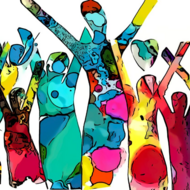How to Create a Vision Board
(View Complete Item Description)How to Create a Vision Board A Copyrighted Activity Created by and Re-posted with Permission from Louise Gale http://www.louisegale.com Objectives: The participants will: 1. Reflect on goals for themselves for a set point in the future 2. Use the art form of collage to manipulate materials and create artwork that symbolizes those goals and visions Audiences: This activity can be used by any age group. Counselors/therapists may adapt this activity for those who are battling depression, addiction, PTSD or other issues. What is a Vision Board and Why is it Important? A vision board is simply a board of any size which has pictures, words and other items collaged onto it. The purpose is to create a picture or vision of what you want to attract into your life—this could be where you’d like to visit or live, changes you’d like to make to your existing environment or life, or how you’d like to feel. Displaying your vision board where you will see it every day will help you “tune your brain”, similar to a radio signal, to remind yourself of the goals you have set as you go about your busy life! Visuals are powerful as they tap into your subconscious more than words. I really like to use a combination of visuals and words as the words will also help increase the emotional response. I usually keep my vision board in my bedroom so I wake up to it every day. Remember you don’t have to do this alone. You can invite your family and close friends to take part.
Material Type: Activity/Lab, Lesson, Lesson Plan




















